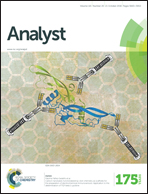Fluorescence recognition of double-stranded DNA based on the quenching of gold nanoparticles to a fluorophore labeled DNA probe†
Abstract
An ultrasensitive fluorescent platform for sequence-specific recognition of double-stranded DNA (dsDNA) based on the quenching of gold nanoparticles (AuNPs) to a fluorophore labeled DNA probe was developed. The target dsDNA could hybridize with the loop portion of the molecular beacon (MB) to form a triplex DNA structure and opened the “stem–loop” structure of the MB; such triplex DNA was used as an assistant probe (AP). Meanwhile, a fluorophore labeled DNA-AuNP probe that contained a specific enzyme cleavage site was introduced and its fluorescence signal was efficiently quenched due to the vicinity of the fluorophore to the AuNP surface. Such a DNA-AuNP probe could hybridize with the 5′ stem portion of the MB in the AP to form duplex DNA strands that contained a specific enzyme cleavage site for the nicking enzyme assisted cleavage reaction, and resulted in the release of the fluorophore from the AuNP surface and the recovery of the fluorescence signal. Because the AP remains intact during such a cleavage process, it could be reused to hybridize with the next DNA-AuNP probe and trigger the nicking nuclease assisted signal amplification. Under optimal conditions, a low detection limit of 3.8 pM was obtained for dsDNA detection, and the assay has high sequence specificity for dsDNA detection.


 Please wait while we load your content...
Please wait while we load your content...